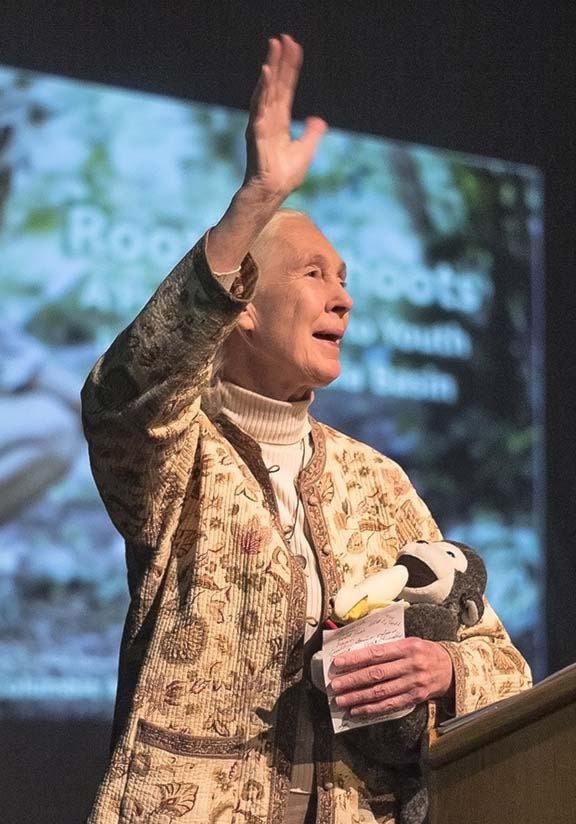There are few words that accurately describe the quickness of Dr. Jane Goodall's trip to the Kootenays. Whirlwind is one that comes to mind. But the legacy she left and the knowledge and ideas implanted into the minds of youth and adults alike is even harder to describe.
Goodall, affectionately known as Dr. Jane to the young people involved in her Roots and Shoots program, was the keynote speaker at a variety of events on September 30 and October 1. She met with educators, business owners, children and more. Not only did she promote Roots and Shoots, but she talked of her illustrious career as a primatologist through engaging storytelling that had audiences of 600 people hanging off her every word.
To the thrill of all audiences, Goodall began each lecture with the pantoot, the call of the chimpanzee. It was returned enthusiastically by both adults and children.
Goodall said her story began as a child who loved animals. She told the Key City Theatre crowd Sunday evening of her mother's support. She once went to bed with a handful of earthworms, and her mother turned that funny experience into a chance to teach a young Jane Goodall where the worms really belong – in the garden – and although she thought they would enjoy a snooze in her human bed, they would die if kept away from their home.
"I was just lucky I had an extraordinary mother," she said.
When Jane was 11 to 12 years old, she first read Tarzan perched in a beech tree at home. It was that story that inspired her to go to Africa later on in life.
"I fell passionately in love with Tarzan, and what did he do? He flippin' married the wrong Jane," she said to much laughter.
Goodall's journey to Africa wasn't a clear path. She was, after all, a girl in the 1960s and international travel was not common for women of her age. But again, her mother's influence prevailed. She told her daughter to find a way, and Goodall did just that. She became a secretary and eventually got invited to holiday in Kenya by a friend. She worked as a waitress to save up money, in a story that is probably being reflected by hundreds of East Kootenay youth this very second.
When she got to Kenya, Goodall did not overstay her welcome, instead taking the opportunity of a job in Nairobi. It was there she met famed archeologist Louis Leakey, whom she impressed with her knowledge of animals despite never setting foot in a university.
"Nothing can compare to that experience of moving away from England," she said. "It was there that Louis Leakey decided I was the one that he was looking for for years."
Leakey gave Goodall a job as a secretary, and started looking for funding to send young Goodall to Gombe Stream National Park to study chimpanzee behaviour. It was a challenge, as Goodall was a young woman. For the first four months of her time in Gombe, Goodall was joined by her mother.
Goodall struggled in those first months, unable to find the breakthrough she was hoping for. She felt pressure to observe something truly remarkable.
"I knew that if I didn't see anything exciting before the money ran out, that I would have let Louis Leakey down," she said. Her mother jumped in, pointing out little curiosities displayed by the chimps – the way they interacted, their family patterns. "She boosted my morale."
After her mother left, Goodall finally saw the breakthrough. Peering through binoculars one day, she spotted a chimp poke a twig into a termite mound, wait a few moments and then remove it, sucking off the termites one by one with his lips. He then picked a branch, stripped it of its leaves, and used that to poke into the mound, fishing for termites. She had just shattered the illusion of man the toolmaker.
The finding was so remarkable that Leakey was able to secure more funding. He even sent a film crew to document Goodall, which was important because Goodall lacked a university education.
Upon return, Leakey decided Goodall had to get that piece of paper – but there was no time for a Bachelor of Education. She went straight to a doctorate in ethology at Cambridge University.
During her time at Gombe, Goodall also noticed aggression in chimpanzees that had never been reported before. She was shocked when other scientists told her not to report her findings.
"Some of these postures are identical to ours," she said. "There were scientists who told me, 'Jane, you should play that down.'"
Goodall didn't. Instead, she thought about the connection between violence amongst chimps and warfare amongst man, and the potential for good and evil in a human being.
"It's up to us to grow one and suppress the other," she said. "There isn't a sharp line between us and the animal kingdom."
Goodall's studies also saw her be accused of what she calls the greatest sin — anthropomorphism, the giving of human traits to animals. This because she opted to give the chimps she studied names rather than numbers, as was common practice at the time.
"Animals indeed are much more like us than scientists would let us believe," Goodall said. She remembers as a child studying her dog named Rusty. She credits the dog with teaching her that animals do have personalities.
When Goodall began researching chimpanzees at Gombe in 1960, she said there were about three million of the animals in 21 different countries. That number dwindled to 300,000 due to the bushmeat trade, forest destruction and more. There are only about 100 chimps in Gombe now.
See more coverage of Goodall's visit in tomorrow's Townsman.
